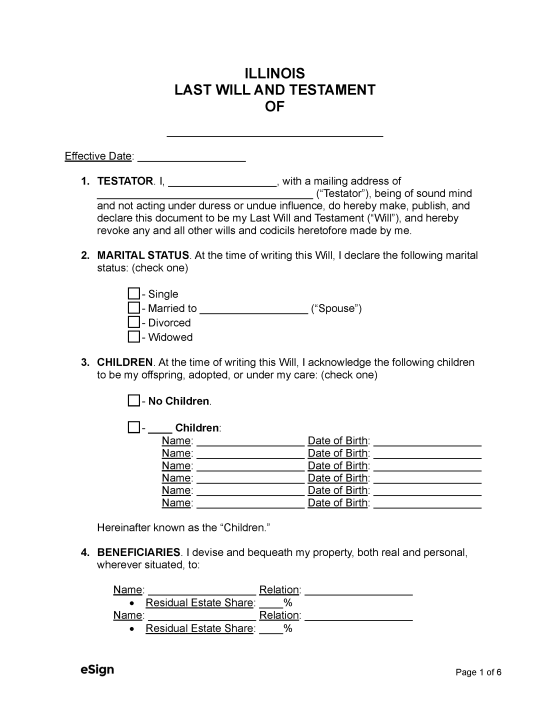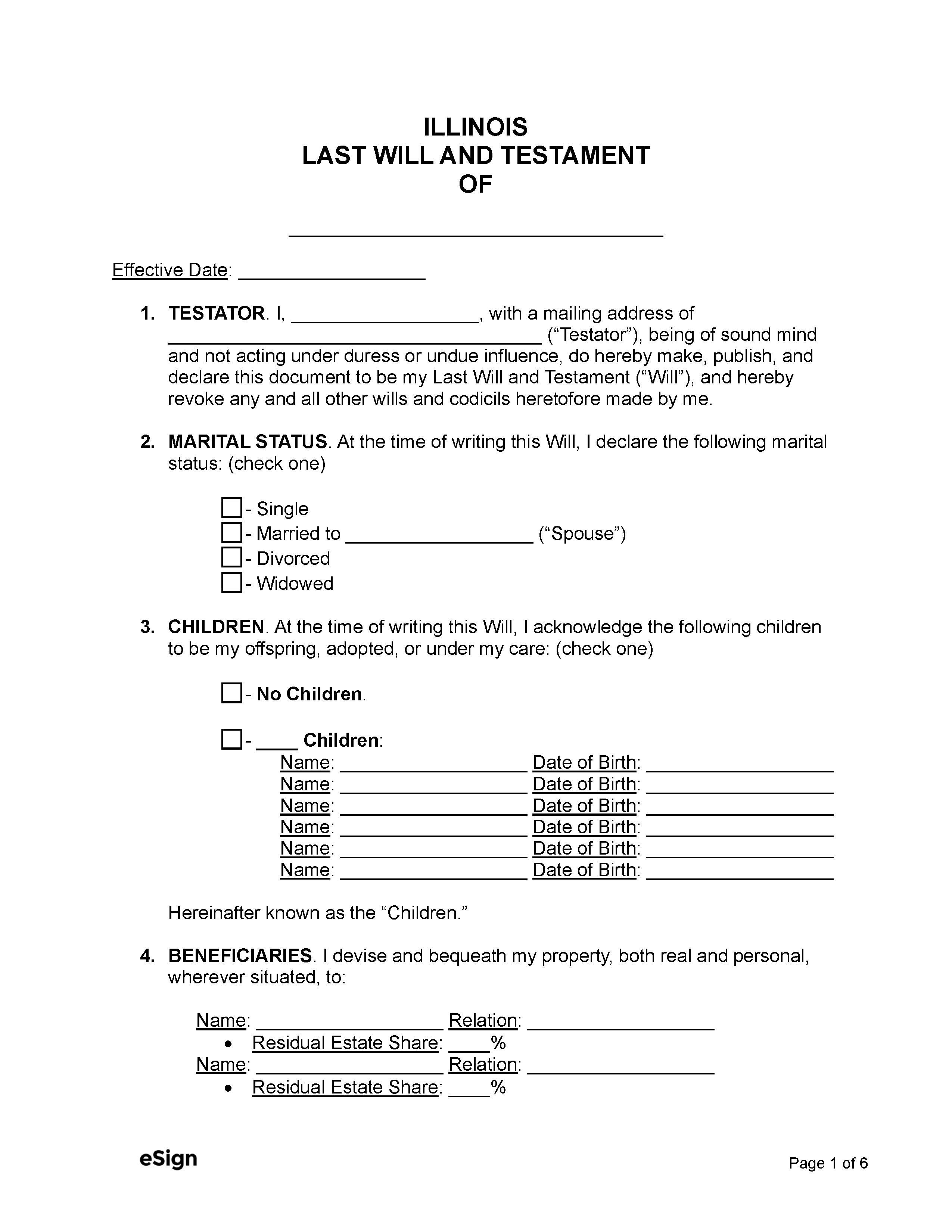State Laws
To make a will, a person must be at least 18 years old and not mentally disabled.[1]
Holographic Wills – A handwritten, non-witnessed will is not recognized in Illinois.[2]
Revocation – The testator may revoke a will by physically destroying the document, executing another will that revokes the prior one, or by written revocation. If the testator divorces their spouse or annuls their marriage, any power of appointment or inheritance granted to the spouse is considered revoked.[3]
Signing Requirements – The testator must sign the will in the presence of two or more witnesses, who are also required to sign the document.
Probate Process in Illinois (10 steps)
When someone with a will dies in Illinois, the named executor has 30 days to file the original document with the court clerk for the county where the decedent resided.[4] The minimum amount of time for probate to be completed is six months from its official opening.
- Prepare Required Documents & Forms
- Oath and Bond of Representative
- File Required Documents & Mail Notice
- Letters Testamentary
- Notice to Beneficiaries
- Notice to Creditors
- Inventory
- Pay Decedent’s Debts & Taxes
- Distribute Assets
- Closing Administration
1. Prepare Required Documents & Forms
If a decedent’s estate is valued at $100,000 or less and contains no real estate, their belongings can be collected without probate.[5] To bypass the court process, an heir or beneficiary of the decedent must complete and notarize a Small Estate Affidavit Form.
Illinois’s most common type of probate is “independent administration,” which allows the executor to handle the decedent’s estate without court supervision.[6]
To begin the independent administration process, the executor named in the decedent’s will must gather and prepare the following documents for filing:
2. Oath and Bond of Representative
Unless the will waives the requirement or the executor is a corporate representative, the executor will be required to post a bond for the decedent’s estate. They must also make an oath of office.[7] To fulfill these requirements, the executor will need to complete and notarize the Oath and Bond of Representative (SAMPLE) form.
3. File Required Documents & Mail Notice
Once all of the documents and forms are ready, the executor will need to file them with the circuit court in the county where the decedent last resided.[8] Some courts will have a special probate division to handle estates. The court will give the executor a date on which the court will review their case.
Notice of Petition
After filing the Petition and at least 30 days before the will is admitted to probate, the executor must mail a Notice (SAMPLE) and a copy of the Petition for Probate of Will to each person named therein.[9]
4. Letters Testamentary
After the executor has submitted the documents required, the circuit court will determine whether the list of heirs contained in the Affidavit of Heirship and the will are legitimate. If everything is in order, the judge will execute the Order Declaring Heirship, an Order Admitting Will to Probate (SAMPLE), and appoint the executor as the estate’s representative by issuing Letters Testamentary.[10]
5. Notice to Beneficiaries
The executor will be required to send a Notice to Heirs and Legatees (SAMPLE) to all of the decedent’s known heirs and beneficiaries within 14 days of receiving Letters Testamentary. If the name or address of any heir is not stated in the Petition, the executor will need to publish a notice once a week for three successive weeks in a local newspaper, with the first publication date being within 14 days of the Order Admitting Will to Probate.[11]
Waiver of Notice
Any heir or beneficiary can complete and file the Waiver of Notice (SAMPLE) form with the circuit court. The executor won’t be required to serve notices to interested parties that file a Waiver.
6. Notice to Creditors
Within 14 days of receiving Letters, the executor must also provide notice to the decedent’s creditors. Any known creditors need to be delivered notice, and other creditors will be notified by publication in a local newspaper. Publication must occur once a week for three consecutive weeks and may be combined with the Notice to Heirs, if such notice is required.[12]
Known creditors will have three months from the delivery date to file claims against the estate. Unknown creditors will be given six months from publication to file claims against the estate.
7. Inventory
Before settling debts and distributing assets, the executor will need to take possession of the decedent’s property and make an Inventory (SAMPLE) of the estate.
Under independent administration, the executor is not required to file the Inventory with the circuit court. However, if a bond was required, the surety on the bond must be provided a copy of the Inventory within 90 days of the executor’s appointment. Any interested persons requesting service must also be delivered copies at least 30 days before a Final Report is filed (see Step 10).[13]
8. Pay Decedent’s Debts & Taxes
The executor will be required to pay for all administration expenses and settle the decedent’s outstanding debts with the estate funds. Payments must be made in the following order[14]:
- Administration, funeral, and burial expenses
- Surviving spouse and child’s awards
- Debts to the United States
- Final medical costs
- Untraceable money or property held in trust
- Debts to state and local municipalities
- All other claims
In addition to settling any unpaid debts, the executor must file the decedent’s final federal and state income tax returns, as well as a federal and state estate tax return (if not exempt).
9. Distributing the Assets
After paying the decedent’s debts and taxes, the executor may distribute the estate’s remaining assets as directed by the will. Receipts must be obtained from each beneficiary for the assets or property they received to be filed with the Final Report (see next step).[15]
Account
The executor must make an Account detailing the administration and distribution of the estate and deliver it to the beneficiaries for approval.[16]
10. Closing Administration
Once all the beneficiaries have approved the Account and six months have passed since the executor was appointed, the estate will be ready for closing. Under independent administration, the executor is not required to submit the Account to the court unless one of the beneficiaries requests it.
Final Report
The executor must complete and file a Final Report (SAMPLE) with the circuit court to close the estate and seek discharge from their appointment. Within 14 days of filing the Final Report, the executor must mail a Notice of Report (SAMPLE) to any party who is entitled to and has not waived notice. The executor will be discharged from their duties 42 days after filing the Final Report if there are no objections.

